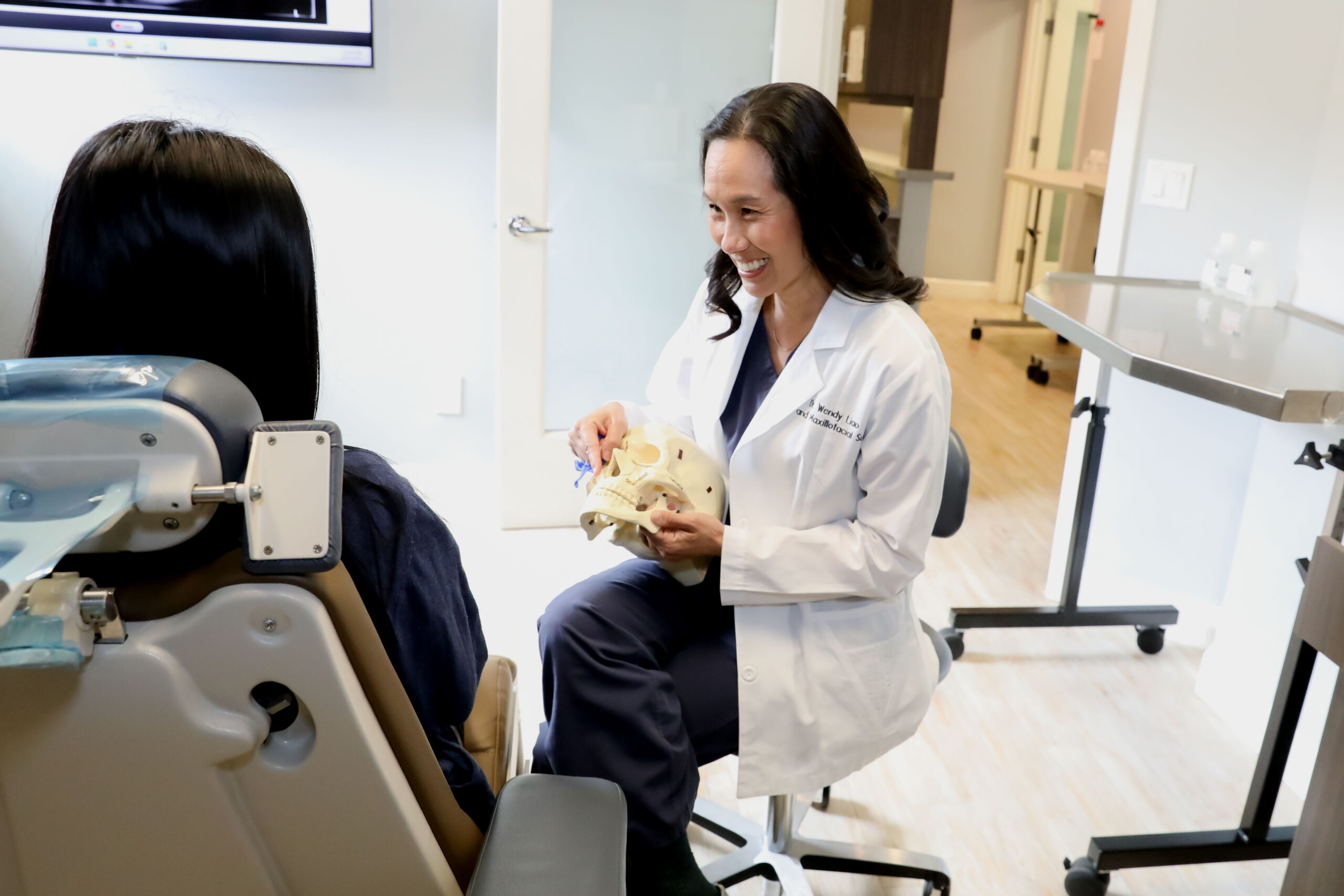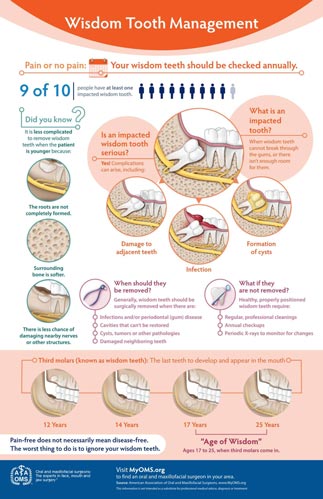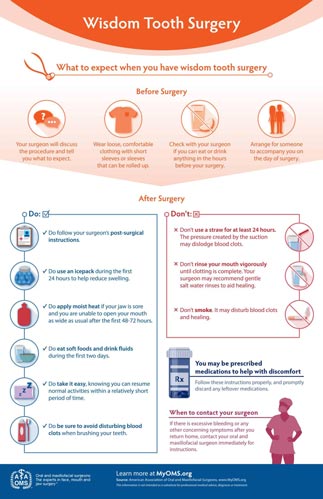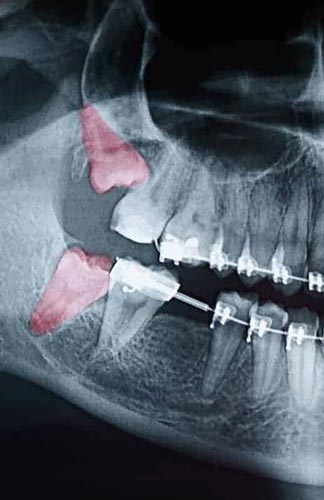Wisdom Teeth Extractions
Wisdom Teeth Removal and Care
Most people’s mouths only have enough room for 28 teeth. When your wisdom teeth start to come in, that’s four additional teeth trying to cram their way in. In the majority of situations, this creates a litany of problems, including crowding, soreness, risk of infection, and the need for extraction. Since your wisdom teeth are the last teeth to erupt through your gums, they come to the party a little late. All your other teeth have settled into their places. With x-rays and inspections, we can determine if your wisdom teeth are impacted and need to be removed.
Wisdom teeth rarely come in straight and even with the rest of your smile. At Parkside Oral Surgery & Implant Center, we have years of experience extracting wisdom teeth to ensure your smile remains one you recognize. Wisdom teeth can also come in sideways, causing even more issues for you if we don’t act. If you or your child is approaching the age of 18, it’s crucial to bring them in for an examination for their wisdom teeth. Call us today to schedule your appointment for a wisdom teeth analysis or extraction in the Oakland and Alameda area.

The Extraction Process
In most extractions, we believe it is easier for the patient to be under anesthesia for the surgery. We first administer laughing gas, or nitrous oxide, to the patient for relaxation. Then, we deliver general anesthesia so that the patient is unconscious throughout the operation. We keep a close watch on you while you’re under, making sure to extract your teeth safely while you stay sedated. After we remove the teeth and roots, we suture the gum, closing the wound and preventing infection. We place gauze into the incision points to control bleeding.
After the surgery, you rest under our supervision until you’re able to be taken home. Our team will provide you with a post-op kit, which includes care instructions, prescriptions, antibiotics, and a follow-up appointment for removing your sutures.
Wisdom Teeth Extractions in Oakland and Alameda
Wisdom teeth, also known as the third molars, are the final teeth to erupt within your mouth, with most patients seeing their appearance in their late teens or early twenties. When these teeth erupt properly, there is no reason to remove them. However, they often do not erupt properly which can cause many other dental issues. In these cases, the team at Parkside Oral Surgery & Implant Center can perform wisdom teeth extractions for Oakland and Alameda area patients. Our team can begin evaluating your wisdom teeth before they even start to erupt, keeping an eye on their formation and progress using x-rays. If we believe the teeth are putting you at risk for oral complications, we’ll suggest removing them and can perform the surgery in our office. Please contact us today if you’d like to learn more about this process.
Wisdom Teeth: Impacted
Wisdom Teeth: Patient Safety
Wisdom Teeth: Impacted or Crowding
Wisdom Teeth: Pain or No Pain
Having Third Molar Surgery
Why Do I Need to Remove My Wisdom Teeth?
Though some patients may not require the removal of their wisdom teeth, most often, it’s needed to protect your overall oral health. Wisdom teeth can begin to grow in sideways, only partially erupt, or even get stuck beneath the gum and bone. Known as impacted teeth, those that get stuck may resort to shifting positions as they try to find a pathway for eruption. When wisdom teeth don’t erupt through the gumline properly, they can create severe problems for the patient, including:
- Risk of infection in tissues surrounding the tooth.
- Disruption to the orthodontic or natural alignment of teeth.
- Formation of tumors or cysts around impacted wisdom teeth, resulting in jawbone or tooth destruction.
We’ll Start With an Oral Examination
To evaluate the state of your wisdom teeth, we’ll first do a thorough examination and take x-rays of your mouth. This will help us determine if your wisdom teeth pose a current or future threat to your oral health. Early detection of issues results in better outcomes for our patients, so we recommend the first evaluation be completed in a patient’s mid-teenage years.
Wisdom Teeth Removal
Before the procedure, we’ll discuss the various forms of anesthesia we may use during your procedure as well as any risks involved. Our primary goal is to ensure your comfort. We also want our patients to be as informed as possible, so there are no surprises. Dr. Liao and Dr. Karwowska at Parkside Oral Surgery & Implant Center will surgically remove your wisdom teeth and suture the gum. You will then rest at the clinic under our supervision. Once we determine that you’re safe to go home, we’ll send you on your way with post-op instructions as well as any necessary prescriptions. You’ll need to return to your follow-up appointment so we can check on your healing progress.
Call Us to Schedule Your Appointment
We take pride in making the entire process as streamlined as possible. The longer you wait to extract impacted wisdom teeth, the more discomfort they can cause, and the more difficult the procedure becomes. Contact our office today for a wisdom teeth consultation.
What Is an Impacted Tooth?
An impacted tooth simply means it is “stuck” and cannot erupt into function. Patients frequently develop problems with impacted third molars, also known as wisdom teeth. These teeth get “stuck” in the back of the jaw and can develop painful infections among a host of other problems. Since there is rarely a functional need for wisdom teeth, they are usually extracted if they develop problems.
The maxillary canine (upper eyetooth) is the second most common tooth to become impacted. Canines are critical teeth in the dental arch and play an important role in your “bite”. Canines are very strong biting teeth and have the longest roots of any human teeth. They are designed to be the first teeth that touch when your jaws close together, so they guide the rest of the teeth into a proper bite.
Having Impacted Canine Surgery
Where Are Impacted Teeth Located?
Normally, maxillary canines are the last “front” teeth to erupt into place. They usually come into place around age 12 and cause any space left between the upper front teeth to close tighter together. If a canine gets impacted, every effort is made to get it to erupt into its proper position in the dental arch. The techniques involved to aid eruption can be applied to any impacted tooth in the upper or lower jaw, but most commonly are applied to maxillary canine (upper eye) teeth. Sixty percent of these impacted eyeteeth are located on the palatal (roof of the mouth) side of the dental arch. The remaining impacted eye teeth are found in the middle of the supporting bone but stuck in an elevated position above the roots of the adjacent teeth or out to the facial side of the dental arch.
Early Recognition Is Key to Successful Treatment
The older the patient, the more likely an impacted canine will not erupt by nature’s forces alone even if space is available for the tooth to fit in the dental arch. The American Association of Orthodontists recommends a panorex screening x-ray, along with a dental examination, be performed on all dental patients at around the age of seven years to count the teeth and determine if there are problems with eruption of adult teeth. It is important to determine whether all adult teeth are present or missing.
Are there extra teeth present or unusual growths that are blocking the eruption of the canine? Is there extreme crowding or too little space available causing an eruption problem with the canine? This exam is usually performed by your dentist or hygienist who will refer you to an orthodontist if a problem is identified.
Treating such a problem may involve an orthodontist placing braces to open spaces to allow for proper eruption of adult teeth. Treatment may also require referral to an oral and maxillofacial surgeon for extraction of over-retained baby teeth and/or selected adult teeth that are blocking eruption of the all-important canines. The oral and maxillofacial surgeon will also need to remove any extra teeth (supernumerary teeth) or growths that are blocking the eruption of any adult teeth.
If the eruption path is cleared and the space is opened by age 11-12, there is a good chance the impacted canine will erupt with nature’s help alone.
If the canine is allowed to develop too much (age 13-14), the impacted canine will not erupt by itself even with space cleared.
If the patient is too old (over 40), there is a much higher chance the tooth will be fused in position. In these cases, the tooth will not budge despite all efforts of the orthodontist and oral and maxillofacial surgeon to erupt it into place.
The only option at this point is to extract the impacted tooth and consider an alternate treatment to replace it in the dental arch (crown on a dental implant or a fixed bridge).
What Happens if the Tooth Will Not Erupt When Proper Space Is Available?
In cases where canines will not erupt spontaneously, the orthodontist and oral and maxillofacial surgeon work together to get these unerupted canines to erupt. Each case must be evaluated on an individual basis, but treatment will usually involve a combined effort between the orthodontist and oral and maxillofacial surgeon. The most common scenario will call for the orthodontist to place braces on the teeth (at least the upper arch). A space will be opened to provide room for the impacted tooth to be moved into its proper position in the dental arch. If the baby canine has not fallen out already, it is usually left in place until space for the adult canine is ready. Once enough space is ready, the orthodontist will refer the patient to the oral surgeon to have the impacted canine exposed and bracketed.
In a simple surgical procedure performed in the surgeon’s office, the gum on top of the impacted tooth will be lifted to expose the hidden tooth underneath. If there is a baby tooth present, it will be removed at the same time. Once the tooth is exposed, the oral and maxillofacial surgeon will bond an orthodontic bracket to the exposed tooth. The bracket will have a miniature gold chain attached to it. The oral and maxillofacial surgeon will guide the chain back to the orthodontic arch wire where it will be temporarily attached. Sometimes the surgeon will leave the exposed impacted tooth completely uncovered by suturing the gum up high above the tooth or making a window in the gum covering the tooth (on selected cases located on the roof of the mouth). Most of the time, the gum will be returned to its original location and sutured back with only the chain remaining visible as it exits a small hole in the gum.
Shortly after surgery, the patient will return to the orthodontist. A rubber band will be attached to the chain to put a light eruptive pulling force on the impacted tooth. This will begin the process of moving the tooth into its proper place in the dental arch. This is a carefully controlled, slow process that may take up to a full year to complete. Once the tooth is moved into the arch in its final position, the gum around it will be evaluated to make sure it is sufficiently strong and healthy to last for a lifetime of chewing and tooth brushing. In some circumstances, especially those where the tooth had to be moved a long distance, there may be some minor “gum surgery” required to add bulk to the gum tissue over the relocated tooth, so it remains healthy during normal function. Your dentist or orthodontist will explain this to you if it applies to your specific situation.
Impacted Canine Braces
These basic principles can be adapted to apply to any impacted tooth in the mouth. It is not that uncommon for both maxillary canines to be impacted. In these cases, space in the dental arch will be prepared on both sides at once. When the orthodontist is ready, the surgeon will expose and bracket both teeth in the same visit, so the patient only has to heal from surgery once. Because anterior teeth (incisors and cuspids) and premolar teeth are small and have single roots, they are easier to erupt if they get impacted than posterior molar teeth. Molar teeth are much bigger and have multiple roots making them more difficult to move. The orthodontic maneuvers needed to manipulate an impacted molar tooth can be more complicated because of their location in the back of the dental arch.
Surgery to Expose and Bracket an Impacted Tooth
The surgery to expose and bracket an impacted tooth is a very straightforward surgical procedure that is performed in the oral and maxillofacial surgeon’s office. For most patients, it is performed under IV sedation. You can expect a limited amount of bleeding from the surgical sites after surgery. Although there will be some discomfort after surgery at the surgical sites, most patients find Tylenol or Advil to be more than adequate to manage any pain they may have. There may be some swelling from holding the lip up to visualize the surgical site; it can be minimized by applying ice packs to the lip for the afternoon after surgery. It is advised that you avoid sharp food items like crackers and chips as they will irritate the surgical site. Your doctor will see you after surgery to evaluate the healing process and make sure you are maintaining good oral hygiene. As always, simply call our office at 510-865-1114 if you have any questions.



